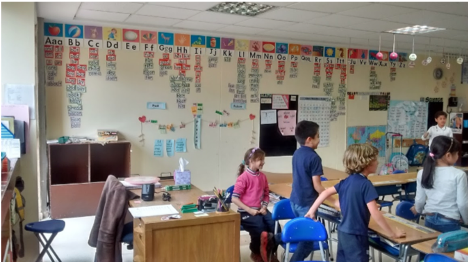The Image of God: Image Reflectors
While this article may seem primarily reflective, it is, in fact, highly practical; our understanding of ourselves and others shapes everything we do and the way we do it. At the heart of all self-understanding is that most practical (and important) of all things: “what comes into our minds when we think about God…”[1]. As such, the teacher’s task is prophetic – seeing things and people from God’s perspective; and priestly – leading our people to the Lord and restoration. The teacher’s high calling helps students see and become what God sees them becoming: a unique beautiful expression of His own image, restored in Christ.

At creation new life burst forth from the Father by Son in the Spirit of love. Earth and all in it mysteriously imaged and revealed something of Heaven’s Glory, as the invisible was made visible.
The climax: “let Us make mankind in Our image, to be like Us!”[2] In His most beautiful, exhilarating, joyous and solemn creative act, God shaped us. He made us fruitful, to re-create and co-create from His inexhaustible creative storehouse, to extend God’s eternal creativity in expanding manifestations of His image, loving rule and generative activity, for His greater glory and His creation’s greater good.When I consider Your heavens, the work of Your fingers, the moon and the stars, which You have ordained; What is mankind, that You take thought of him? And the son of man, that You care for him? You have made them a little lower than the angels and crowned them with glory and honour. You made them rulers over the works of your hands; you put everything under their feet.[3]
God directly shaped Adam from the dust breathing Spirit-energy into him; then He crafted Eve from sleeping Adam’s side, breathing His Spirit into her.
Eden—the beautiful, restful, fruitful Garden of God—was a stunning backdrop for the work-play of God’s children. The grandeur of God’s image—mental, physical, emotional, spiritual, creative—was perfectly expressed in Adam and Eve! God’s royal representatives ruled wisely, maintaining the harmony of the Garden of God. Knowing God, they knew the secrets of His creation.
Their prayer life was quiet, brilliant, energising, beautiful, true, kind, restful, comfortable, strong, gentle; deep words interspersed with golden, restful, informative, expectant, receptive, expressive silence.
Our longing for a better world is our shared memory of Eden and a yearning for a future better world – past and future glory in this moment’s disappointment, the awakening of our soul to our true longing.
At the heart of being God’s image is choice, without which love cannot exist. Right choosing means choosing to love, obey, trust, and serve God. Our fullest capacity to create flows from full alignment with our Creator; here we are most creative, joyful, effective and loving, most fully alive as God’s image.
Choosing for self-advancement, self-glory, self-reliance (i.e. against God and His glory in seeking the best for the other and for God’s creation) is sin, a posture and activity whereby we miss the mark, falling far short of the glory of God.
The secret of strength—doing the will of the Father in humble reliance and obedient response to having received all from him—becomes twisted into what Satan calls a weakness. All we are and have is gift and grace.
Because of God’s grace and mercy freely offered by Christ, the way back is always available. Our pilgrimage is all  about God restoring us – and through us others and His creation – as His image in Christ, who is the perfect image of God.
about God restoring us – and through us others and His creation – as His image in Christ, who is the perfect image of God.
Augustine states: “the Godhead of the Holy Trinity and the image to which man is made are one”[4]. God’s will is that we who were created like Him, yet distinct from Him, should be united with Him in fruitful, intimate union. Our destiny is to become reflectors of God’s restored image:
And the glory which You have given Me I have given to them; that they may be one, just as We are one; I in them, and You in Me, that they may be perfected in unity, that the world may know that You sent Me, and loved them, even as You loved Me. Father, I desire that they also, whom You have given Me, be with Me where I am, in order that they may behold My glory, which You have given Me; for You loved Me before the foundation of the world[5].
“He has made everything beautiful in its time. He has also set eternity in their heart….”[6]
Howard Dueck, M.A.
Latin America/Beyond Borders Regional Director
TeachBeyond Global
________________________________________
[1] Tozer, A.W. The Knowledge of the Holy. 4.
http://www.fremontalliance.net/hp_wordpress/wp-content/uploads/2014/06/KotH-Tozer.pdf
[2] Genesis 1:26
[3] Psalm 8:3-6
[4] Augustine. Confessions. Book XII, article 5. Translated by R S Pine-Coffin. Harmondsworth, Middlesex, England: Penguin Books, 1979.
[5] John 17:22-24
[6] Ecclesiastes 3:11
Photo Credits: Sunlight. Le dahu Flickr via Compfight cc. Sunset. JerzyGorecki via Pixabay.
________________________________________
 Howard Dueck (MA, Biblical Counselling), together with his wife Eileen, began their service with TeachBeyond in 1988 in Brazil, where Howard taught, counselled and was involved in leadership at the Gramado Bible College. He continued counselling and teaching when they moved to Germany. He is currently based near Winnipeg, Canada, and serves as the TeachBeyond regional director for Latin America and director for Beyond Borders (TeachBeyond’s education outreach to displaced persons).
Howard Dueck (MA, Biblical Counselling), together with his wife Eileen, began their service with TeachBeyond in 1988 in Brazil, where Howard taught, counselled and was involved in leadership at the Gramado Bible College. He continued counselling and teaching when they moved to Germany. He is currently based near Winnipeg, Canada, and serves as the TeachBeyond regional director for Latin America and director for Beyond Borders (TeachBeyond’s education outreach to displaced persons).



 Have you ever found yourself rushing through the last bit of lecture so that you can finish up before the bell rings? Calling out homework assignments as students trickle out the door? Ending in the middle of an activity because the specials teacher is waiting? If you are like most teachers, the answer to these questions is probably a resounding yes.
Have you ever found yourself rushing through the last bit of lecture so that you can finish up before the bell rings? Calling out homework assignments as students trickle out the door? Ending in the middle of an activity because the specials teacher is waiting? If you are like most teachers, the answer to these questions is probably a resounding yes. ficult or confusing in this chapter is… b/c… but I overcame my challenge by…
ficult or confusing in this chapter is… b/c… but I overcame my challenge by…
 All of us can improve both our memory and our ability to transfer knowledge to unfamiliar situations with active effort. The most effective learning takes place when students are faced with desirable difficulty—a learning task that requires effort at a level slightly beyond the expected level for students.[2] Unfortunately, this effort is hard and most of us don’t naturally choose to do things the hard way. In fact, in their research, Brown, et al., discovered that most people revert to study patterns that require less effort even after experiencing greater learning using more difficult study techniques.[3] As fallen people, we want to believe that we can somehow get something for nothing—or as close to nothing as possible. We want to abandon our calling to cultivate in favour of an easier path.
All of us can improve both our memory and our ability to transfer knowledge to unfamiliar situations with active effort. The most effective learning takes place when students are faced with desirable difficulty—a learning task that requires effort at a level slightly beyond the expected level for students.[2] Unfortunately, this effort is hard and most of us don’t naturally choose to do things the hard way. In fact, in their research, Brown, et al., discovered that most people revert to study patterns that require less effort even after experiencing greater learning using more difficult study techniques.[3] As fallen people, we want to believe that we can somehow get something for nothing—or as close to nothing as possible. We want to abandon our calling to cultivate in favour of an easier path. I’ve found that the hardest part for me in designing this type of learning activity is getting myself out of the way. My tendency is to want to jump in and direct the students, to help them discover the answer. I want to prevent them from taking wrong turns or making common mistakes. Unfortunately, when I do this, I am unwittingly preventing my students from doing the work of thinking themselves. I am hindering, rather than empowering, learning.
I’ve found that the hardest part for me in designing this type of learning activity is getting myself out of the way. My tendency is to want to jump in and direct the students, to help them discover the answer. I want to prevent them from taking wrong turns or making common mistakes. Unfortunately, when I do this, I am unwittingly preventing my students from doing the work of thinking themselves. I am hindering, rather than empowering, learning.



 As teachers, we should help students see needs of those who can’t help themselves. Perhaps this is as simple as a daily look at the “news.” Maybe it is choosing books that expose students to the struggles of others. However we choose to do this, we may have to break out of our comfortable routines to help students see and care about justice.
As teachers, we should help students see needs of those who can’t help themselves. Perhaps this is as simple as a daily look at the “news.” Maybe it is choosing books that expose students to the struggles of others. However we choose to do this, we may have to break out of our comfortable routines to help students see and care about justice. As teachers, we can build activities into our curriculum where students can practice justice. Consider picking a project and committing to it for the year with bulletin boards and regular updates[2]. Or encourage your students to respond to a need in your own community. When you hear about injustice, help students to always ask, “What should we do?”
As teachers, we can build activities into our curriculum where students can practice justice. Consider picking a project and committing to it for the year with bulletin boards and regular updates[2]. Or encourage your students to respond to a need in your own community. When you hear about injustice, help students to always ask, “What should we do?”

 What are key components to the curriculum that I want to reference with my students?
What are key components to the curriculum that I want to reference with my students? red pencils, scissors, glue, etc. that students can access without adult assistance. Additionally I have a designated location for water bottles, backpacks, and lunch boxes. It takes time to teach the routines and procedures necessary for taking care of classroom materials, but with intentionality it is possible.
red pencils, scissors, glue, etc. that students can access without adult assistance. Additionally I have a designated location for water bottles, backpacks, and lunch boxes. It takes time to teach the routines and procedures necessary for taking care of classroom materials, but with intentionality it is possible.
 I engage my students in examining, then critiquing, how humankind is making use of the resources that God has given us.
I engage my students in examining, then critiquing, how humankind is making use of the resources that God has given us.


 There are some common themes that run through the various illustrations. One is that often the goals pursued by these heroes seemed completely unattainable. Think of the stories of Sarah, Joshua, Gideon and others. The thing they hoped for seemed impossible. Another common theme is the lack of resources that these characters faced. How could Gideon possibly win a battle against the vast Midianite army with only 300 men? How could Moses lead the Israelite slaves out of powerful Egypt? And even should they succeed, what was there in the desert to sustain them? A third theme is obedience: these heroes of the faith reached their goal because they did what God challenged them to do. This is true even when they could not see the outcome they were working towards, a final theme of this chapter.
There are some common themes that run through the various illustrations. One is that often the goals pursued by these heroes seemed completely unattainable. Think of the stories of Sarah, Joshua, Gideon and others. The thing they hoped for seemed impossible. Another common theme is the lack of resources that these characters faced. How could Gideon possibly win a battle against the vast Midianite army with only 300 men? How could Moses lead the Israelite slaves out of powerful Egypt? And even should they succeed, what was there in the desert to sustain them? A third theme is obedience: these heroes of the faith reached their goal because they did what God challenged them to do. This is true even when they could not see the outcome they were working towards, a final theme of this chapter.